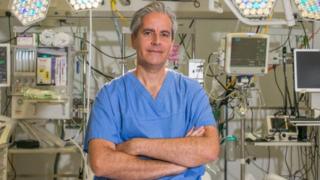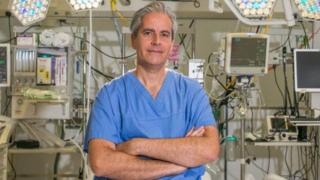A week in the life of a London trauma surgeon
Prof Karim Brohi describes holding a stabbed man’s heart in his hands amid rising knife crime in the capital. …

 Image copyright Karim Brohi
Image copyright Karim Brohi Every 75 minutes, someone in London is admitted to hospital with traumatic injuries, according to the capital’s ambulance service. In a week-long diary for the BBC, the London Trauma System’s clinical director describes the moment he held a stabbed man’s heart in his hands and how rising knife crime is “taking its toll” on the healthcare system.
Monday – Spleen removal
Prof Karim Brohi is the clinical director of the London Trauma System, which oversees trauma care at 30 hospitals across the capital.
He clocks in at the Royal London Hospital Major Trauma Centre – run by Barts Health NHS Trust – at 08:00 BST and is now its on-call trauma surgeon with overall responsibility for patients until the same time the following Monday.
There are 42 patients on the trauma ward when he arrives, including an injured 15-year-old boy, eight stabbings and four gunshot wounds.
Despite this, it’s a relatively quiet day and he clocks off two hours late at 19:00. But within a couple of hours, he is called back to treat a teenager who has been stabbed multiple times.
“A CT scan reveals severe injuries,” Prof Brohi says. “We take him to surgery and open his abdomen. He has life-threatening injuries to his lung and spleen and has lost a significant amount of blood.
“We have to resuscitate him as we proceed with surgery, before removing his spleen. Finally he stabilises and we are able to fix his other injuries.”
Tuesday – 50/50 chance
The teenager from the previous evening is now “stable and doing well”, despite losing his spleen. But overnight there are six new trauma patients, including two stabbing victims.
During morning rounds a Code Red comes in – a man has has been hit by a car and has a severe pelvic fracture and bleeding.
Specialist radiologists are called into perform a procedure known as an embolisation – where blood vessels are clogged with medical glue or tiny beads – to stop the bleeding.
“The patient is taken to intensive care for further stabilisation, where specialist pelvic surgeons will take care of the next stage of his care,” Prof Brohi explains.
“Luckily he has no brain injury, but it’s going to be a long rehabilitation process and I would expect there’s only a 50/50 chance he ever returns to work.”
What happens during a Code Red?
A Code Red is called in by paramedics when a patient may have only minutes to live.
A team of specialists from around the hospital assemble in the major trauma unit and key staff are put on stand-by. An emergency operating theatre is put on hold and a CT scanner is held empty for the patient.
Different types of blood are thawed and special components to help with procedures like embolisation are delivered.
The patient arrives and a team of doctors and nurses have seconds to diagnose the problem and begin treatment.
Wednesday – Keyhole surgery
It’s a quiet night, with only two new admissions. Monday’s teenage stabbing victim is improving, despite being in a “fair bit of pain”.
Another teenager on the ward who was stabbed a week ago still has a large blood clot in his chest, which requires treatment.
“I take him to surgery and we collapse his lung down and remove the clot using a keyhole surgery approach,” says Prof Brohi.
“About half a litre of blood and a clot is removed. He’ll be sore tomorrow from the new drains we have placed but hopefully will now make a good recovery – physically anyway.”
The key facts about rising knife crime
Thursday – Flashbacks and panic attacks
A patient with very bad head injuries from an accident comes in overnight and the critical care team is brought in to support the “distraught” family.
The prognosis is poor and “the next 24-hours will be critical,” according to Prof Brohi.
Elsewhere on the ward, four stabbing victims cannot be discharged because they are at risk of further violence if they return home.
“Sometimes, despite our combined best efforts, people come back having been attacked again,” the surgeon says.
“Even for those who do go home, we know the level of post-traumatic stress for these people is extraordinarily high – many confine themselves to their own home, too afraid to go out.
“They stop socialising or attending school or college. They have flashbacks and panic attacks. The stress on the family is immense.”
The hospital’s trauma service works with St Giles Trust, which helps to steer people away from violent crime.
Since joining forces with the charity, the hospital says it has seen a “substantial reduction in the proportion of people under 25 returning to hospital with further violent injuries”, with fewer than 1% of cases returning to the trauma unit. But Prof Brohi believes the trust needs more support.
“It is excellent in providing support for young people after they leave hospital, but their resources and reach is limited. We work hard to try to find a safe environment for these patients, but it can take time.”
What is the London Trauma System?
The system encompasses four networks, each led by a major trauma centre at St Mary’s, St George’s, King’s College, and Royal London hospitals.
Between them they provide major trauma care to some 30 hospitals and health units across London and their resources are combined to ensure they provide care 24 hours a day.
Since it was established in 2010, the London Trauma System says it has improved access to specialist trauma treatments and improved quality of care.
It was the first system of its kind in the country and research by the Queen Mary Centre for Trauma Sciences shows death rates in the most critical patients have halved in 10 years.
Patients treated by the London Trauma System
People seen across the four networks in 2016/17
Friday – Hole in the heart
Sadly, the prognosis of Thursday’s head injury patient was accurate and she rapidly deteriorates and dies.
She has no other medical problems and could be a potential organ donor, which “may be the only good that ever comes of such cases,” Prof Brohi says.
He spends the afternoon with the research team, which is conducting studies into improving survival rates from major trauma.
Later, a Code Red brings the surgeon back to the hospital at 22:00 BST – a young man has been stabbed in the chest, and his vital signs are deteriorating.
“The patient’s blood pressure is falling rapidly. The trauma team has already started to resuscitate him and put him to sleep and my surgical registrar has started to open his chest, while I quickly gown up.
“There is a massive blood clot around the heart stopping it beating which we rapidly remove, revealing a large laceration to the heart itself.
“We control this with our hands while the team continue to resuscitate him and together we get his heart beating strongly again. My registrar then sews up the hole in his heart and we take him up to the operating room to complete the operation, closing his chest.
“Just after midnight we go to speak to his family. I’m hopeful he will do well. But whatever the outcome, these conversations with a family in the relative’s room in the middle of the night mark the beginning of a horrendous chapter in all their lives – from which some may never recover.”
Saturday – Dangerous amount of blood
A young girl comes into the trauma ward losing a dangerous amount of blood after falling and cutting through the main artery in her arm.
By the time she reaches hospital, paramedics have the bleeding temporarily controlled with a pressure bandage.
“We whisk her up to the operating room to take a look while she is asleep under anaesthetic,” says Prof Brohi.
“Her artery is repaired and then our plastic surgeons do a great job of turning a horrible wound into a neat scar. She’s transferred to the paediatric ward and her arm should hopefully be fine.”
A busy Saturday night sees nine further trauma patients admitted – four of which are stabbings. Two have injuries to their lungs, one to the liver.
Luckily, none are serious enough to be operated on by Prof Brohi. Their acute injuries are managed and they are admitted for observation.
Sunday – Pancreas in half
Prof Brohi is at home playing Lego with his daughter when he gets a call that a man has been stabbed in the chest, back and legs. Although initially declared a Code Red, a CT scan reveals no major injuries and the surgeon is stood down and the registrar takes over.
Later that evening there’s another stabbing. This time, Prof Brohi is called straight to theatre.
“We open his abdomen to find the knife has gone completely through his stomach and cut his pancreas in half.
“We repair his stomach but need to remove half of his pancreas. He should have enough pancreas left so he is not rendered diabetic, but as always, time will tell.
“He is at very high risk of infections and abscesses and it’s possible he will need several more procedures after this.”
Prof Brohi says some of the violence he sees is “hard to even begin to comprehend”.
“There is no doubt that seeing these cases takes its toll on healthcare staff. But it can be nothing compared to being a teenager who is exposed to, and in fear of, this level of violence on a day-to-day basis.
“The level of stress and anxiety on these kids, and their family, is unfathomable.”
The surgeon believes violence is increasing not just on London’s streets, but across the country.
“We do our best to save lives. But to really save a life – and make one that’s worth living – takes a whole community.
“We need to look again at our society, our culture and our values if we are to live in a world where children can be children, and mothers can be mothers, without ever having to sit in a hospital waiting room.”
The rest of the night is, thankfully, quiet. At 08.00 BST on Monday, Prof Brohi hands the service over to a colleague, and a new week on the trauma ward begins.
You might also be interested in:
Why are more and more adults wearing braces?
The homeless teen who studied by candlelight
‘I call my stem cell donor my sister’

